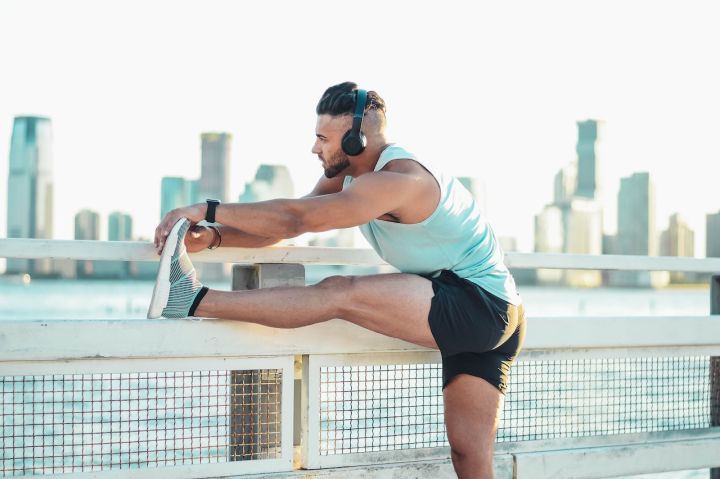The wall squat is a great training move. You can do them anywhere, not only to do them, but to do them correctly. Today we will make some useful suggestions on how you can control the pace of your workout.

The wall static squat is a move that looks a bit rustic, a bit boring and not very active, but it's really good for you.
Read on, are your gluteus maximus, quads and core ready?
How to do the wall squat properly

Stand with your back to the wall and feet hip-width apart.
Tighten your core muscles and bring your hips back against the wall. Bend your knees until your thighs and calves form a 90 degree angle.
Hold this position, keeping your spine vertical.
This movement sounds fairly simple and not too difficult. However, there are still some movement adjustments that can be made to give your muscles better stimulation.
Push hard on the whole foot

There shouldn't be any space between your heel and the floor or between your toes and the floor, it should all be completely pressed against the floor.
You want to press your entire foot to the floor. Imagine pressing your big toe, little finger and heel to the floor.
Tighten your torso

At this point you should notice that we have reminded you (twice) to keep your core tight.
So here's another reminder to brace your vertical spine.
Keeping your core muscles taut will protect your lower back and spine, if you fail to do this your lower back will be overstretched and even injured.
Upper body power up

Your legs may be the first muscle group to feel the burn, but that doesn't mean your upper body is at rest.
Imagine holding a piece of paper in your armpit, which creates tension in your upper body.
Want to know why you need to do this? If your upper body is activated, this will help prevent your shoulders from leaning forward, which can put your lower back in a less than ideal position.
Also, where tension is created, the muscles are built up so that the whole body gets a workout all over.
Squeeze your gluteus maximus

You can easily miss the opportunity to strengthen your gluteus maximus during wall static squats. You need to be careful and make sure you keep squeezing your gluteus maximus.
As you squat, visualise the contraction and squeeze in your glutes. Doing so will better prepare you for movements such as air squats, back squats and front squats.
Keep a neutral neck
When your neck is in a neutral position, your head is right above your neck. It is not twisted, tilted or twisted.
Wall static squat benefits
Builds muscle

Before you can understand why wall squats are such an effective strength exercise, you must understand muscle isometric contraction training.
Isometric contraction training is generally an exercise where the muscles do not show a change in length.
You start a movement that requires a group of muscles to fire while holding a position, keeping those muscles under tension throughout.
The wall static squat exercise definitely falls into this category. Other examples are the plank hold.
Isometric contraction training forces your muscles to remain under tension for a prolonged period of time, ultimately achieving an increase in strength.
The longer you are under tension = more active muscle fibres = more muscle destruction = more muscle growth = more strength and muscle mass.
Benefits of increasing muscle mass:
Faster metabolism increased calorie burn increased fat burning reduced risk of injury no equipment required

In fact, all you need is a wall, wall cabinet or pole, or a workout buddy to support yourself.
Very many variations

If the classic wall squat is too hard for you, you can adjust the height on the wall a little to ease the tension in your quads, or you can put a chair underneath you so you feel more secure.
You can also sit on the edge of a chair and squeeze your gluteus maximus, quads and hamstrings hard to get a similar effect.

However, if you want to increase the intensity of the wall squat, you can simply use a weight or exercise ball and place it in front of your body or on your legs.
Wall squat vs air squat

The wall squat is a great base exercise for the air squat.
The wall squat teaches people to maintain a tight core, which they need to master the air squat. Not having the strength to support your lower back when squatting in an air squat can cause your back and shoulders to lean forward excessively, which can put your spine in a bent position.
If air squats have become part of your exercise routine, then video yourself. If your back develops a c or s shape during exercise, then incorporate more core strengthening movements into your routine, such as wall squats.
How long can you hold each wall squat for?

It really depends on your goals.
If you are using wall squats to work on air squats or to strengthen your core, we recommend that you hold it in good form for as long as possible, rest for one to two minutes, and then repeat three times.
If you use this instead of barbell back squats, you will need to hold it for a longer period of time. Suggestion: 5 reps of 1-2 minutes each, with 30 seconds rest in between.
You can also use wall static squats as a warm-up for weighted squats.

Wall squats like all other workouts should feel like a challenge, but after training at your own pace for a while, feel your muscles and they if they have adapted then change the time or rest period each time to vary the stimulation of the muscles.

